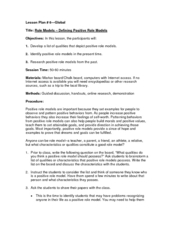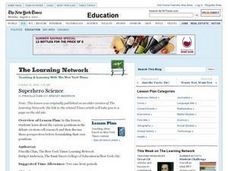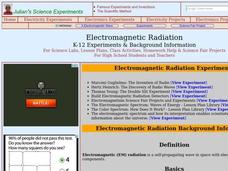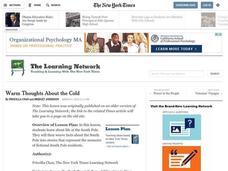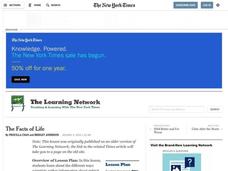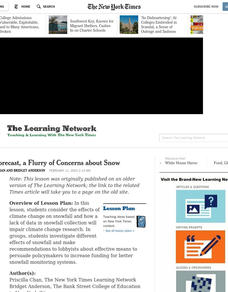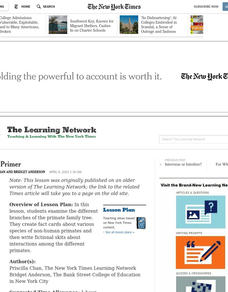Curated OER
Role Models - Defining Positive Role Models
Being able to identify what characteristics make a good role model is one way for students to better understand their own positive behaviors. The class brainstorms what characteristics make up a good role model, research a role model...
Curated OER
What's The Story?
Teams of learners integrate reading, writing, math, social studies, and science in this simple, yet effective lesson plan. They work in groups in order to solve a ten-step problem which requires internet research, the use of a...
Curated OER
Short and Sweet Science
Readers learn how to summarize scientific text and evaluate the advantages, disadvantages, and challenges in writing summaries. They select science-related articles you've pulled and collected from the New York Times and, with a partner,...
Curated OER
A New Era for Palestinians
Get a global perspective and examine the challenges facing Mahmoud Abbas, the newly elected president of the Palestinian Authority. Thoughtful classroom citizens write letters to Mr. Abbas, asking him questions and suggesting advice....
Curated OER
Superhero Science
Young scientist explore the various positions in the debate on stem cell research and then discuss these perspectives before formulating their own positions. They must research the topic and beliefs that others have. They will also look...
Curated OER
Organ Music
Middle and high schoolers solve a riddle about the appendix, and explore the paradox surrounding this organ. They research other human body organs to create a paper model of the human body, and write riddles highlighting identifying...
Curated OER
E.T., Are You Out There?
Research the necessary components of a planet that supports life after reading the article "All of a Sudden, The Neighborhood Looks a Lot Friendlier" from The New York Times. After finding their information, middle and high schoolers...
Curated OER
Electromagnetic Radiation
Students explore the nature of electromagnetic spectrum through a series of experiments. In this physics lesson, students determine how light behaves under certain circumstances. They explain how humans perceive colors.
School Improvement in Maryland
Political Systems: Advantages and Disadvantages
Every political system has advantages and disadvantages. To gain an understanding of these differences, groups investigate the political system of another country—oligarchy, monarchy, dictatorship, parliamentary—and prepare a...
Curated OER
Warm Thoughts About the Cold
“What do you think life is like at the South Pole?” After responding to this journal prompt, class members read and discuss the New York Times article, “At South Pole, New Home for a New Era.” Using resources available from the Times’...
Curated OER
A Discourse on the History of Language
Analyze and make inferences from the information used by linguists to construct the evolution of languages. They research different dating techniques to explain how scientists infer age with evidence.
Curated OER
Hieroglyphic Art Project
Students translate words and ideas into pictures. They make a list of words or phrases that could be drawn as symbols. Students complete this as part of a project on Egyptian and other civilizations that used hieroglyphics. They use...
Curated OER
Reporters at Gettysburg A WebQuest
Learners create newsletters about the Battle of Gettysburg. In this Civil War lesson plan, students create a webquest based on the battle. Learners use the information and sources to create a Gettysburg newsletter.
Curated OER
BLAST Algorithm
Students explore a series of activities on using BLAST. In this biology lesson, students explain the significance of BLAST in DNA query. They give real world applications of BLAST.
Curated OER
Choosing the Lincoln Statue
Fourth graders research photographs or artwork depicting Abraham Lincoln during the time when he was traveling the 8th Judicial Circuit and practicing law in Champaign County. They develop a Powerpoint presentation of the results of the...
Curated OER
Using Newsprint as a UV Detector
Students investigate the effects of UV radiation. In this earth science lesson, students explain how the time of day relate to UV abundance on Earth. They determine if weather affects the amount of UV that Earth receives.
Curated OER
Comparing Countries
Students use a graphic organizer to research, compare and contrast two countries. They write a brief (or detailed - depending on age) report of their findings.
Curated OER
The Facts of Life
Young scholars explore the different ways scientists gather information about extinct animals. They utilize these methods to create illustrated story books about a particular extinct animal.
Curated OER
Fighting the War in Your Head
Students analyze the experiences of a fictional soldier in a war and create a mental health profile for that individual. They emulate psychiatrists and propose treatment strategies for their particular soldier's post-traumatic stress...
Curated OER
Tribal Truths
Students research and analyze the interactions of American Indian tribes with Meriwether Lewis and iam Clark. Then they stage displays to inform the public about their findings.
Curated OER
In the Forecast, a Flurry of Concerns about Snow
Students consider the effects of climate change on snowfall and how a lack of data in snowfall collection impair climate change research. They, in groups, investigate different effects of snowfall and make recommendations to lobbyists.
Curated OER
A City Lost and Found
Students hypothesize about the origins of the Incan lost city of Machu Picchu. They examine archaeological methodologies used by researchers to piece together the history of the site and create an audio tour of the location for visitors...
Curated OER
Primate Primer
Young scholars examine the different branches of the primate family tree. They create fact cards about various species of non-human primates and then write fictional skits about interactions among the different primates.
Curated OER
Creature Creation
Students explore the characteristics of dragons as represented in the myths of cultures around the world. They create their own mythical dragons by hybridizing two creatures with desirable traits and writing stories about their creation.


